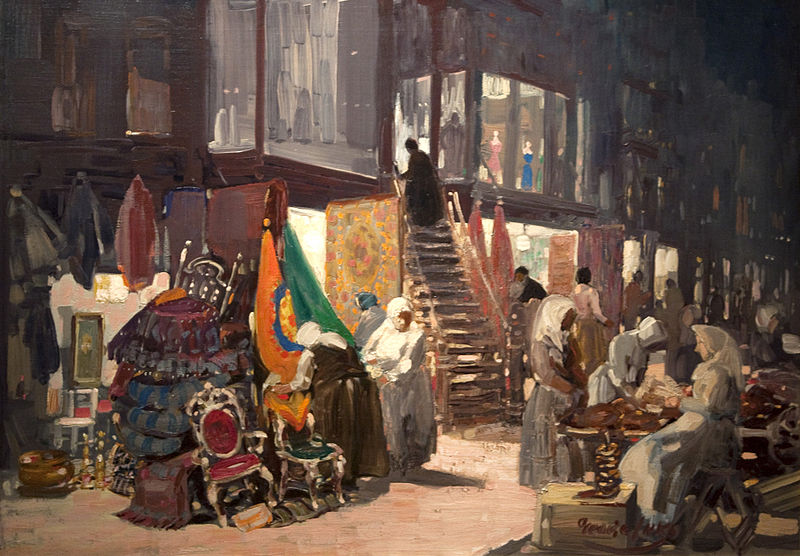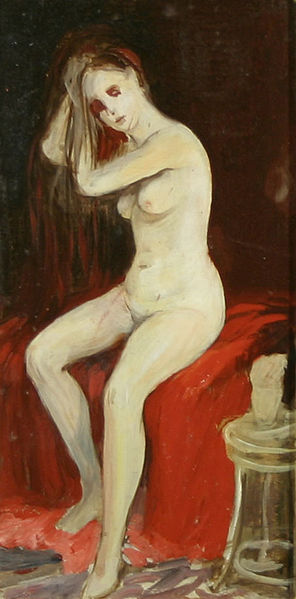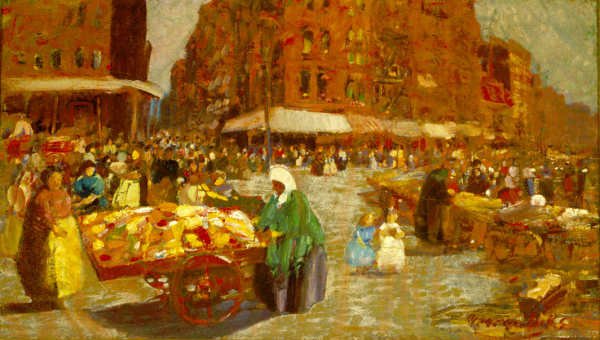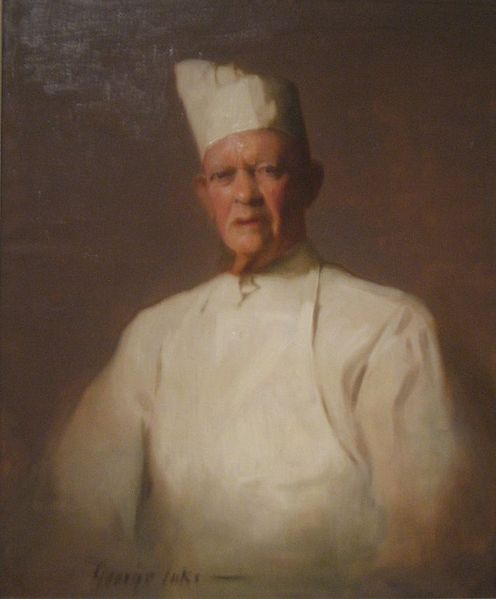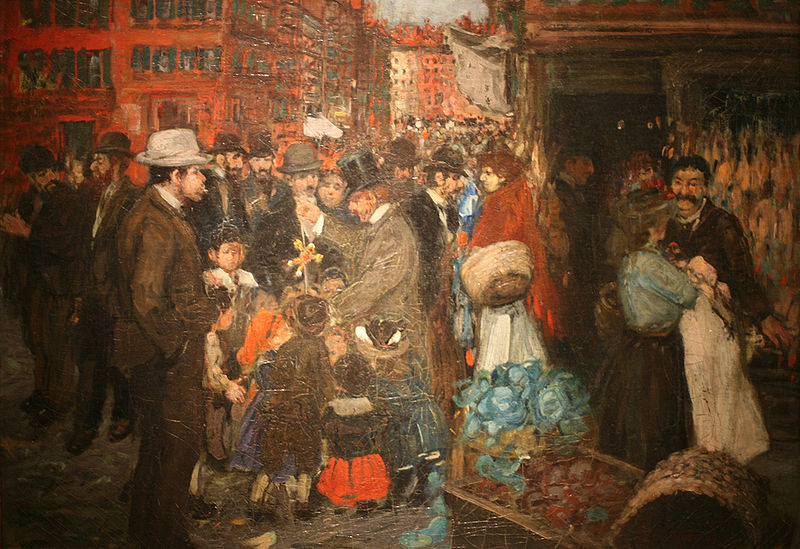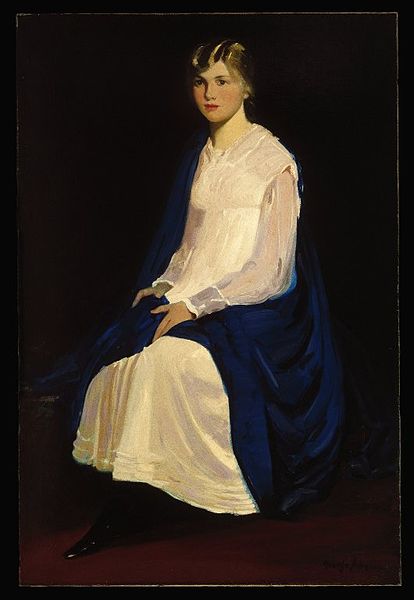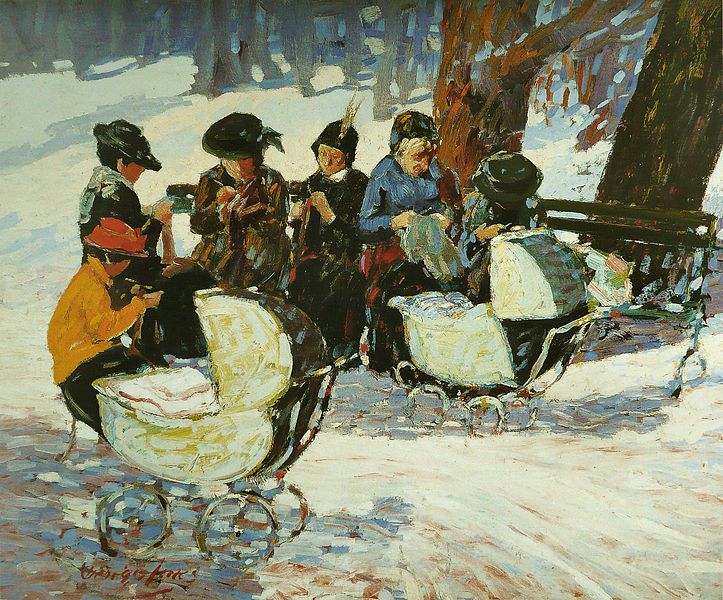<Back to Index>
- Painter George Benjamin Luks, 1867
PAGE SPONSOR
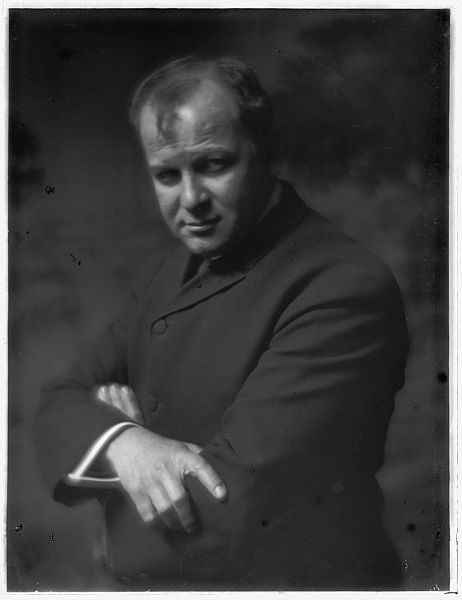
George Benjamin Luks, (August 13, 1867–October 29, 1933) was an American realist artist and illustrator. His vigorously painted genre paintings of urban subjects are examples of the Ashcan School in American art.
Luks was born in Williamsport, Pennsylvania, to Central European immigrants. His father was a physician and his mother was an amateur painter and musician. The Luks family (George, his parents and five siblings) eventually moved to Pottsville, in Southern Pennsylvania near the coal fields. In this setting, he learned at a young age the importance of compassion by watching how his parents helped the coal miners' families, and many believe that this is the reason why lower class New Yorkers were often Luks's subject matter. Luks studied at the Pennsylvania Academy of Fine Arts before he traveled though Europe where he attended several art schools. Later he went to Düsseldorf where he lived with a distant relative, a retired lion tamer. He is associated with the Düsseldorf school of painting. He abandoned Düsseldorf for the more stimulating spheres of London and Paris. He then returned to Philadelphia in 1893 where he was an illustrator for the Philadelphia Press where he met John Sloan, William Glackens and Everett Shinn. They would meet at the studio of Robert Henri, an artist who emphasized the depiction of ordinary life, shunning genteel subjects and painting quickly. The group became known as the "Philadelphia Five". In 1896, Luks moved to New York and began his art career there as the premier humorist artist for the New York World. During his time as an illustrator there, he lived with William Glackens. Glackens, along with Everett Shinn and Robert Henri, encouraged him to paint seriously, and Luks developed an interest in painting "New York Street Life". The Philadelphia Five eventually became "The Eight."
The rejection of one of Luks's paintings from the 1907 exhibition of the National Academy of Design motivated Henri's followers to form their own independent exhibiting group. Consisting of Robert Henri, George Luks, William Glackens, John Sloan, Everett Shinn, Arthur B. Davies, Ernest Lawson and Maurice Prendergast, the group exhibited as "The Eight" in January 1908. Their exhibition was one of the most important events in the development of twentieth century American art. Although the styles of "The Eight" differed immensely, what unified the group was their advocacy of exhibition opportunities free from the jury system, as well as each of their desires to use painting techniques that were not sanctioned by the Academy. "The Eight" expanded into what is now known as the Ashcan School of artists.
Luks made many paintings of working class subjects and scenes of the urban street. "Hester Street" (1905, in the Brooklyn Museum, New York) captures the Jewish court through Luks's vigorously painted representation of immigrant shoppers, pushcart peddlers, casual strollers and curious onlookers of the ethnic variety that characterized metropolitan, turn - of - the - century New York. Luks's work typifies the 'real - life' scenes painted by the Ashcan School artists. It was very important for the artists associated with the Ashcan school to depict real life. They wanted to capture a moment in time. Due to the chaos that was depicted, these realists works of art makes the viewer feel involved in the space. Hester Street demonstrates the ability Luks had to capture expressions, gestures as well as background details that portrayed everyday life in New York City.
The Ashcan School successfully challenged academic art institutions. Like many members of The Eight, Luks was a professor of art, first at the Arts Student League and later at a school he established himself. As noted, the Ashcan School was not an organized group. The first known use of the "ash can" terminology in describing the movement was by Art Young, in 1916, but the term was applied later not only to The Eight, but also to such artists as Edward Hopper (a student of Henri), George Bellows (another student of Henri), Mabel Dwight and others such as photographer Jacob Riis, who portrayed urban subject matter, also primarily of New York's working class neighborhoods. (Hopper's inclusion in the group [which he forswore] is ironic: his depictions of city streets are almost entirely free of the usual minutiae, with not a single incidental ashcan in sight.)
In 1905, Luks painted what would become one of his most famous works as well as an Ashcan School icon, "The Spielers", which is now in the Addison Gallery of American Art. Two young girls make up this painting. Their happy faces contrast with their grimy hands. George Luks successfully portrays lower class children's ability to enjoy life despite their circumstances. He painted the truth, as he saw it. In regard to color, Luks said himself when interviewed, "I'll tell you the whole secret! Color is simply light and shade. You don't need pink or grey or blue so long as you have volume. Pink and blue change with light or time. Volume endures."
Although Luks is best known for his depictions of New York City life, he also created landscapes the city provided, such as The New York River, New York 1910. His visual perception was very fine and emphasized character through the use of his vivid color. An example of his later work, Society Girl (c. 1920s), interpreted wealth, and the importance of society which was an important aspect in portrait painting seen as far back as in the works of John Singleton Copley. The Cafe Francis 1906, has more impressionist aspects than his usual dark scenes of lower class urban life. For example, Sulky Boy (1908, Phillips Collection, Washington D.C.) depicts the son of a doctor at Bellevue Hospital who treated Luks for alcoholism. It was noted that Luks was more concerned with depicting the boy's demeanor rather than the accurate representation of the surroundings.
Luks was a born rebel. He prided himself on being the "bad boy" of American Art, and downplayed Henri's influence on his artistic development. Luks was a heavy drinker, and his friend, one - time roommate and fellow member of "The Eight", William Glackens, often had to undress him and haul him to bed after a night of drunken debauchery. Although many sources confirm this tendency, they also equally characterize him as one with a kind heart who befriended people on the street who often became his subjects for his works of art. An example of this is The Rag Picker (1905), in which Luks depicted exquisite details of the elderly homeless person who knew all too well of the harsh realities of the street. Luks's friends adored him because of his humor and the way he inspired them. They understood and accepted his unusualness.
Luks was found dead by a police officer in October, 1933 after he had died in the early hours of the morning after a bar room brawl. Ira Glackens, the son of William Glackens, wrote of his recollection of Luks's death, stating that the papers proclaimed George was found dead at the doorway when he had planned on going to paint the dawn, when in actuality, the harmless old man had been beaten to death by one of the other customers at the bar. In reference to his funeral, it was crowded by family and past and present friends. He was buried in an eighteenth century embroidered waistcoat that was one of his most important and valuable possessions. According to newspaper reports, Luks funeral took place in New York City on Broadway 31 October 1933. His body was then transferred for burial via the Reading Railroad, Philadelphia PA to Royersford PA on the 11:25 train. A brief ceremony took place and he was buried with his late parents, Mr. & Mrs. Emil Luks. Fernwood Cemetery.
